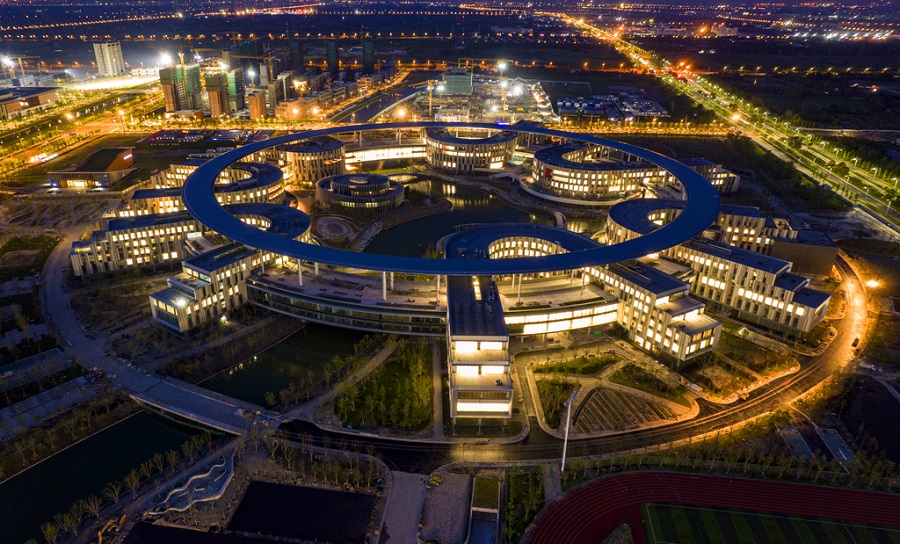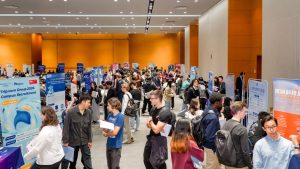22 Aug 2022
A research paper written by a team of undergraduates and PhD students from XJTLU Entrepreneur College (Taicang) has been accepted for presentation at a top biomedical conference.
The paper, ‘Stepwise Feature Fusion: Local Guides Global’, has been accepted by the 25th International Conference on Medical Image Computing and Computer Assisted Intervention (MICCAI), the top international conference in the field of artificial intelligence medical imaging.
The MICCAI conference series started in 1998 with the merger of CVRMed (Computer Vision, Virtual Reality and Robotics in Medicine), MRCAS (Medical Robotics and Computer Assisted Surgery) and VBC (Visualisation in Biomedical Computing).

In the study, the students present a new algorithm that will help diagnose colorectal cancer. Colorectal cancer is a common and often lethal cancer, but the risk of it developing may be reduced through early screening and removal of colon polyps. Colonoscopy, the most efficient and recognized colon polyp detection technology currently available, is necessary for the early screening and prevention of colorectal cancer. However, due to the varying size and complex morphological features of colonic polyps and the indistinct boundaries between polyps and intestinal mucosa, accurate segmentation of polyps is still challenging.
This paper proposes a novel deep-learning model, SSFormer, which shows improved results compared with previous algorithms for accurate polyps segmentation tasks in Colorectal cancer prevention.
EMBRACE UNCERTAINTY
One of the team members, Qiming Huang, a Year Three student from the Data Science and Big Data Technology with Contemporary Entrepreneurialism programme at XJTLU Entrepreneur College (Taicang), says: “The research topic was determined after continuous attempts at polyp segmentation with different algorithms. Although deep learning has become popular for accurate polyp segmentation tasks with excellent results, existing models are unable to process unseen colonoscopy data [data that the model has not previously learnt]. We were curious and excited to address this, and it meant we were free to explore lots of possible research avenues.
“However, the uncertainty also presented a big challenge for us as we have limited research experience. We had to embrace the anxiety brought about by uncertainty and seize the opportunity instead.”
Huang says that despite the challenge of studying this topic, he immediately applied to join the scientific research team to work alongside two PhD students. He has always dreamt of gaining research experience in this field. Huang and the team were supervised by Dr Jionglong Su, Director of Education and R&D Institute, School of AI and Advanced Computing.

Night view of XJTLU Entrepreneur College (Taicang)
Huang says that joining the scientific research project was a great opportunity but needed hard work and commitment, especially to expand his research skills. He particularly enjoyed the experience of collaborating with PhD students.
“We proposed various research ideas and discussed them with PhD students based on reading existing literature and studies. PhD students have a rich and professional knowledge of artificial intelligence and biomedical imaging research and thus gave us a lot of theoretical knowledge support,” says Huang。
“We worked together to develop a feasibility analysis and report. Although we had many failures while building the model, this research is the best result of many explorations and experiments.”
INTERDISCIPLINARY RESEARCH
Huang emphasises the importance of practicality in the interdisciplinary field of artificial intelligence and medicine when discussing his future research goals.
“Much of the existing literature is just based at the theoretical level. After in-depth research, I found that there is a big gap between theoretical knowledge and practice. This problem is evident in the industry, and many problems are waiting to be solved. “I would like to explore the subject more and help make the interdisciplinary field of artificial intelligence and medicine more practical.”
Huang will start his internship at a research centre at Shenzhen University this summer and will continue to study how artificial intelligence can more effectively empower the medical field.
Dr Jionglong Su says: “It is rare for undergraduate students to present a paper as first authors at a top conference in biomedical imaging. This interdisciplinary research is the result of a successful collaboration between different schools.”
Sifan Song, one of the PhD students participating in the research team, previously graduated from the Department of Biological Sciences in XJTLU. He says, “My undergraduate training and
supervision from Professor Jia Meng opened up to me a new world of interdisciplinary research. I am also deeply grateful for Professor Meng’s help with this paper.”
The study, Stepwise Feature Fusion: Local Guides Global, will be published in the 2022 MICCAI conference proceedings.
By Shihuai Wang
Edited by Catherine Diamond
22 Aug 2022







